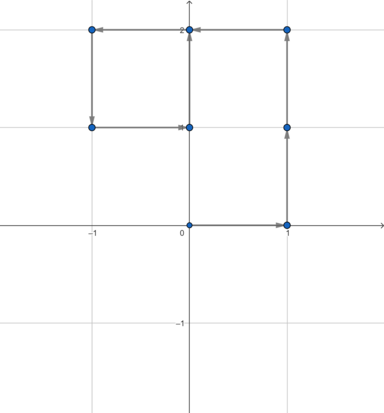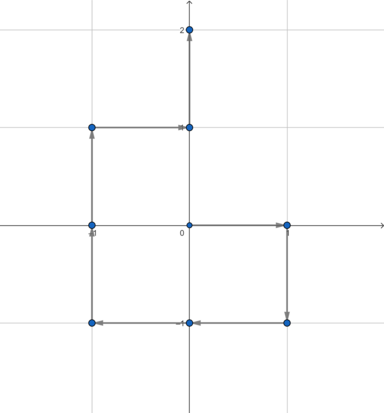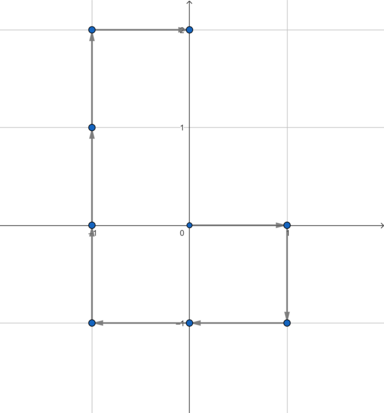310869: CF1902D. Robot Queries
Description
There is an infinite $2$-dimensional grid. Initially, a robot stands in the point $(0, 0)$. The robot can execute four commands:
- U — move from point $(x, y)$ to $(x, y + 1)$;
- D — move from point $(x, y)$ to $(x, y - 1)$;
- L — move from point $(x, y)$ to $(x - 1, y)$;
- R — move from point $(x, y)$ to $(x + 1, y)$.
You are given a sequence of commands $s$ of length $n$. Your task is to answer $q$ independent queries: given four integers $x$, $y$, $l$ and $r$; determine whether the robot visits the point $(x, y)$, while executing a sequence $s$, but the substring from $l$ to $r$ is reversed (i. e. the robot performs commands in order $s_1 s_2 s_3 \dots s_{l-1} s_r s_{r-1} s_{r-2} \dots s_l s_{r+1} s_{r+2} \dots s_n$).
InputThe first line contains two integers $n$ and $q$ ($1 \le n, q \le 2 \cdot 10^5$) — the length of the command sequence and the number of queries, respectively.
The second line contains a string $s$ of length $n$, consisting of characters U, D, L and/or R.
Then $q$ lines follow, the $i$-th of them contains four integers $x_i$, $y_i$, $l_i$ and $r_i$ ($-n \le x_i, y_i \le n$; $1 \le l \le r \le n$) describing the $i$-th query.
OutputFor each query, print YES if the robot visits the point $(x, y)$, while executing a sequence $s$, but the substring from $l$ to $r$ is reversed; otherwise print NO.
ExamplesInput8 3 RDLLUURU -1 2 1 7 0 0 3 4 0 1 7 8Output
YES YES NOInput
4 2 RLDU 0 0 2 2 -1 -1 2 3Output
YES NOInput
10 6 DLUDLRULLD -1 0 1 10 -1 -2 2 5 -4 -2 6 10 -1 0 3 9 0 1 4 7 -3 -1 5 8Output
YES YES YES NO YES YESNote
In the first query of the first sample, the path of the robot looks as follows:

In the second query of the first sample, the path of the robot looks as follows:

In the third query of the first sample, the path of the robot looks as follows:

Output
在一个无限的二维网格中,有一个机器人初始位于点 (0, 0)。机器人可以执行四个命令:U(向上移动一格),D(向下移动一格),L(向左移动一格),R(向右移动一格)。给定一个长度为 n 的命令序列 s,机器人将按照这个序列移动。现在有 q 个独立查询,每个查询包含四个整数 x, y, l 和 r,需要判断在执行序列 s 的过程中,但子串从 l 到 r 反转的情况下(即命令顺序为 s_1 s_2 s_3 … s_{l-1} s_r s_{r-1} s_{r-2} … s_l s_{r+1} s_{r+2} … s_n),机器人是否会经过点 (x, y)。
输入输出数据格式:
输入:
- 第一行包含两个整数 n 和 q,分别表示命令序列的长度和查询的数量。
- 第二行包含一个长度为 n 的字符串 s,由字符 U、D、L 和 R 组成。
- 接下来 q 行,每行包含四个整数 x_i, y_i, l_i 和 r_i,描述一个查询。
输出:
- 对于每个查询,如果机器人会经过点 (x, y),则输出 YES,否则输出 NO。
LaTeX 格式的公式:
题目中没有提供需要用 LaTeX 格式表示的公式。题目大意: 在一个无限的二维网格中,有一个机器人初始位于点 (0, 0)。机器人可以执行四个命令:U(向上移动一格),D(向下移动一格),L(向左移动一格),R(向右移动一格)。给定一个长度为 n 的命令序列 s,机器人将按照这个序列移动。现在有 q 个独立查询,每个查询包含四个整数 x, y, l 和 r,需要判断在执行序列 s 的过程中,但子串从 l 到 r 反转的情况下(即命令顺序为 s_1 s_2 s_3 … s_{l-1} s_r s_{r-1} s_{r-2} … s_l s_{r+1} s_{r+2} … s_n),机器人是否会经过点 (x, y)。 输入输出数据格式: 输入: - 第一行包含两个整数 n 和 q,分别表示命令序列的长度和查询的数量。 - 第二行包含一个长度为 n 的字符串 s,由字符 U、D、L 和 R 组成。 - 接下来 q 行,每行包含四个整数 x_i, y_i, l_i 和 r_i,描述一个查询。 输出: - 对于每个查询,如果机器人会经过点 (x, y),则输出 YES,否则输出 NO。 LaTeX 格式的公式: 题目中没有提供需要用 LaTeX 格式表示的公式。